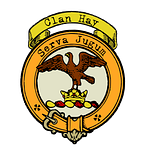Welcome back to "A Clan A Day Podcast." I'm your host, Colin MacDonald. Today, we’re diving into the riveting tale of Clan Wallace, a Lowland Scottish clan whose legacy is inseparably tied to the struggle for Scottish independence. The name Wallace, originating from the Old French "waleis" meaning "Welshman," is a nod to the clan’s early roots, possibly tied to the Strathclyde Britons, long before they became one of Scotland’s most renowned families.
The origins of Clan Wallace trace back to the 11th century, when they first arrived in Scotland. The Wallace family likely came north from Oswestry on the Welsh border, following the trail of Norman influence during the reign of David I of Scotland. One of the earliest known Wallaces, Richard Walensis, accompanied Walter FitzAlan, the High Steward of Scotland, and was granted lands in Ayrshire by 1160. Richard's settlement in Ayrshire eventually became known as Riccarton, a name that still endures today as a testament to his legacy.
The Wallace family quickly established themselves as prominent landholders in both Ayrshire and Renfrewshire. Richard’s grandson, Adam, held the title of the 4th Laird of Riccarton, while Adam's brother, Malcolm Wallace, was granted lands in Elderslie, Renfrewshire. This branch of the family would become the lineage of Scotland's greatest patriot and hero, Sir William Wallace.
Sir William Wallace is perhaps the most iconic figure in Scottish history. Born into a time of great turmoil, young William was thrust into the struggle against English rule when he and his mother were forced to flee from the English forces near Dunipace. As a young man, Wallace quickly rose as a leader among the Scottish patriots, using his military prowess to harass the English occupiers and inspire a movement for independence. His tactics and successes earned him widespread support among the Scottish nobles and made him a figure feared by Edward I of England.
The climax of Wallace’s military career came in 1297 at the Battle of Stirling Bridge. Here, alongside Andrew de Moray, Wallace led a force of Scots to a stunning victory over the English army. This victory not only solidified his reputation as a military genius but also led to his knighthood and appointment as Guardian of Scotland. However, Wallace's triumph was short-lived. The following year, in 1298, he faced a crushing defeat at the Battle of Falkirk, largely due to the overwhelming numbers and superior tactics of the English forces.
Despite this setback, Wallace’s fight for Scottish independence had ignited a flame that would burn throughout Scotland. Unfortunately, Wallace's relentless campaign against English rule led to his betrayal and capture at Robroyston near Glasgow in 1305. He was handed over to Edward I by Sir John Mentieth, a fellow Scot, and was taken to London where he was unjustly tried for treason. The trial was a mere formality, as Wallace had never sworn allegiance to Edward. He was sentenced to a brutal execution, being hanged, drawn, and quartered at Smithfield. His death was intended to extinguish the Scottish rebellion, but instead, it only strengthened the resolve of his countrymen. The spirit of independence that Wallace embodied would ultimately lead to the decisive victory at Bannockburn in 1314 under Robert the Bruce.
The Wallace legacy, however, did not end with William. The clan continued to play significant roles in Scottish history. In the late 14th century, the Wallaces of Cragie, who descended from William Wallace's uncle, secured their position through marriage and military service. Sir John Wallace of Cragie commanded Scottish forces at the Battle of Sark in 1449, securing another victory against the English. Later, in 1513, William Wallace of Carnell fell fighting at the Battle of Flodden, further cementing the clan’s reputation as fierce warriors.
As Scotland moved into the 17th century, the Wallaces were again at the forefront of conflict. Sir Hugh Wallace raised a regiment to support King Charles I during the turbulent times of the Puritan revolution. The clan’s loyalty to the Stuart cause was unwavering, a trait that had been passed down through the generations.
The Wallace clan also produced several notable figures beyond the battlefield. In the 17th century, John Wallis, a mathematician, made groundbreaking contributions to the development of calculus and the concept of infinity. In the 19th century, Alfred Russel Wallace, a naturalist and author, independently developed a theory of evolution that paralleled Charles Darwin’s work. This intellectual legacy added yet another dimension to the clan’s storied history.
Today, Clan Wallace remains a proud and enduring symbol of Scottish identity. The current chief, Andrew Robert Wallace, 36th Chief of Clan Wallace, continues to uphold the family’s traditions. His father, Ian Francis Wallace, was a staunch advocate for preserving the clan’s heritage until his passing in 2016. The Wallace name, synonymous with the fight for freedom, carries on as a beacon of Scotland’s indomitable spirit.
The memory of William Wallace is immortalized in several monuments across Scotland, most notably the towering National Wallace Monument near Stirling. These memorials stand as a testament to a man and a clan whose courage and sacrifice shaped the course of Scottish history.
Thank you for joining us on this journey through the history of Clan Wallace. Be sure to tune in tomorrow for another episode of "A Clan A Day Podcast." I'm Colin MacDonald, and as always, Go n-éirí an bóthar leat.













Share this post